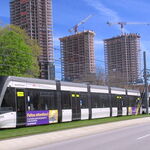The land being contested in the present Hydro-One dispute south of Brantford has no bearing on the *already privately-held land" on the old Harrisburg alignment. (Some may be local municipal, I'll dig later) To try and equate the two is to bring up the same in Toronto. Six-Nations, specifically (IIRC) some of the bands, have had an *historical* claim to what's now being contested, further complicated in this case because the Railway Act (and Expropriation Act) are federal. The Ontario Electricity Act is...obviously...provincial, albeit there is a provincial expropriation power too. Under the Indian Act (federal) it may not apply. If *anyone* is aware of a pending claim on the Harrisburg alignment (the RoW grandfathered from the days of the Great Western) then by all means, post reference. I was digging on it extensively last night. There's a number of disused alignments through and around Paris, Harrisburg and Brantford, some of which are still visible on Google satellite .
Urban Sky posts:
What makes you so certain that HFR would not be able to recover their operating costs?
Here's what I posted, and you quoted:
[[...] If the 'report' comes back very favourable for the new VIA plan, it will allow the Feds to invest *along with private capital* to at least supplement the operating costs. [...]]
You fail to consider what the term "at least" means. It's a cautionary proviso that you might be wise to adopt, and it revolves around the same point of "0% subsidy" that seems to be a sore point for you.
To go to the public and make that claim is to set yourself up for a very embarrassing climbdown. We've seen a litany of these claims over the years, and just as you counsel caution as to the 'three years for the $3M"...you'd be wise to adopt latitude on the operating subsidy point.
W/o getting too political, Trudeau clinched this last election when he defied the claims of the other two major parties to state: (gist) "We are going to run deficits". The public can *accept that* (within reason) as being realistic and necessary, and polls clearly show the public still agreees on the point.
Be *very careful* you don't blow your whole campaign on something as unrealistic as "0% operating subsidy". Private investors will also find it realistic, some will expect and require it in their calculations. The question is "how much" and "is it sustainable over the length of our investment?"
Edit to Add: Paul, your post went up as I was typing mine. Big thumbs up from me! We make a point that, at least with the demographic of this forum, is almost a given.
VIA must be judged on *transit* terms, and even GO, the highest fare-box return of any system in North Am (including Amtrak) still needs roughly a 25% operating subsidy. And it is an *excellent return* for the taxpayer at that in terms of saving money elsewhere.





